Deductive Reasoning Tests: Essential Guide (2025)
The deductive reasoning test is basically a logic test. It checks how well you can take a general rule and apply it to a specific situation to come up with a conclusion. So instead of guessing or using gut instinct, you're using structured thinking — kind of like solving a puzzle.
One example of a deductive reasoning test is the SHL Verify G+ Test which is designed to evaluate a candidate's ability to analyze patterns, identify logical relationships, and make reasoned conclusions. Many employers globally use this test as part of their hiring process, particularly for roles that require problem-solving, strategic thinking, and decision-making skills.
If you're preparing for a Deductive Reasoning Test, this guide will help you:
- Understand what a Deductive Reasoning Test is.
- Learn the test format and structure.
- Explore common question types with examples.
- Discover effective strategies to improve your score.
- Deductive Reasoning practice tests and preparation tips.
By the end of this article, you'll have all the knowledge needed to excel in your deductive reasoning assessment.
What is a Deductive Reasoning Test?
Definition & Purpose:
A Deductive Reasoning Test is usually delivered via an online multiple-choice or interactive assessment that evaluates a candidate's ability to:
- ✅Recognize patterns and relationships in structured data
- ✅Apply logical thinking to solve problems
- ✅Draw valid conclusions based on given information
Deductive reasoning tests frequently use adaptive testing so the questions get harder if candidates keep getting them correct. As a result, all candidates find the test extremely challenging regardless of how well they do and all candidates are likely to get questions wrong.
The test is intended to put significant time pressure on candidates and everyone will find it hard to finish in the time provided. Not completing all questions within the time limit or getting questions wrong is not indicative of a poor performance. This is just an aspect of the testing process which is intended to identify the limit of a candidates ability in an particular area.
Deductive vs Inductive Reasoning
The main difference between deductive and inductive reasoning has to do with how conclusions are reached.
- ✅Deductive Reasoning: Starts with a general rule or principle which is used to determine whether a conclusion is true or not using top down logic. If the premises are true, the conclusion must be true: this is known as deduction logic or deductive thinking.
- ✅Inductive Reasoning: Starts with specific observations and draws a general conclusion using bottom up logic. This is known as induction thinking: the conclusion is likely, however not guaranteed.
Which Companies use Deductive Reasoning Tests?
Companies in various industries use Deductive Reasoning Tests as part of their selection process, including:
- 1️⃣
Finance & Banking
Optiver, HSBC, Barclays, J.P. Morgan
- 2️⃣
Consulting & Business Services
PwC, Deloitte, EY
- 3️⃣
Technology & IT
IBM, Accenture, Cisco, Experian
- 4️⃣
Engineering & Manufacturing
Siemens, General Electric, Rolls-Royce
Many employers use this test to screen candidates before interviews or as part of a larger assessment center.
SHL Verify G+ Deductive Reasoning Test Format
The most common deductive reasoning test: the SHL Verify G+ Test is an IQ-based exam comprising logical, deduction and mathematical questions. There are two variants of this test:
Variant 1: Multiple Choice
- • 30 questions
- • 36 minutes time limit
- • Multiple choice format
- • Standard elimination techniques apply
Variant 2: Interactive (Most Common)
- • 24 questions
- • 36 minutes time limit
- • Interactive question format
- • Currently the more common version
Deductive and Inductive Examples
Here are some commmon deductive and inductive reasoning examples:
1. Grouping Style Questions
This question type requires candidates to use deductive and inductive thinking to assign meeting rooms to individuals based on their constraints including:
- •Room preferences
- •Meeting length
- •Room availability
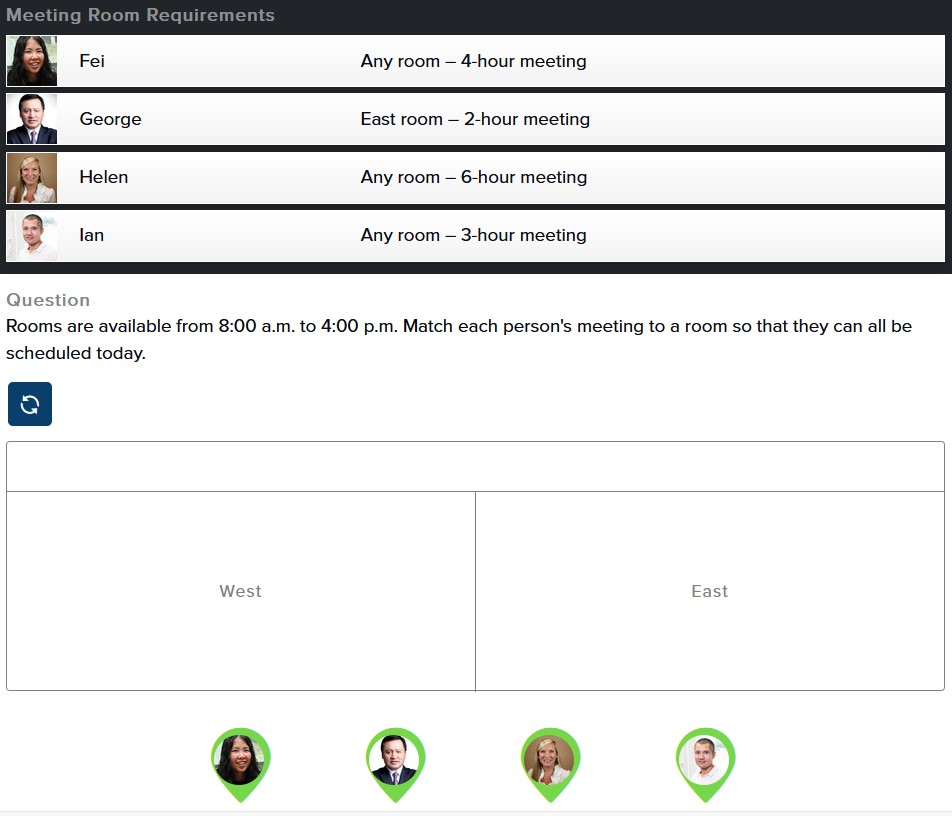
How to Answer:
- 1.Drag the green individual pins into the desired boxes
- 2.Assign based on given requirements
- 3.Use the blue reset button to move all pins back to original positions if needed
⚠️Note: Questions become progressively more challenging by introducing additional requirements and more groups.
2. Ranking Style Questions
This question type requires candidates to use a deductive approach to rank individuals based on their performance information.
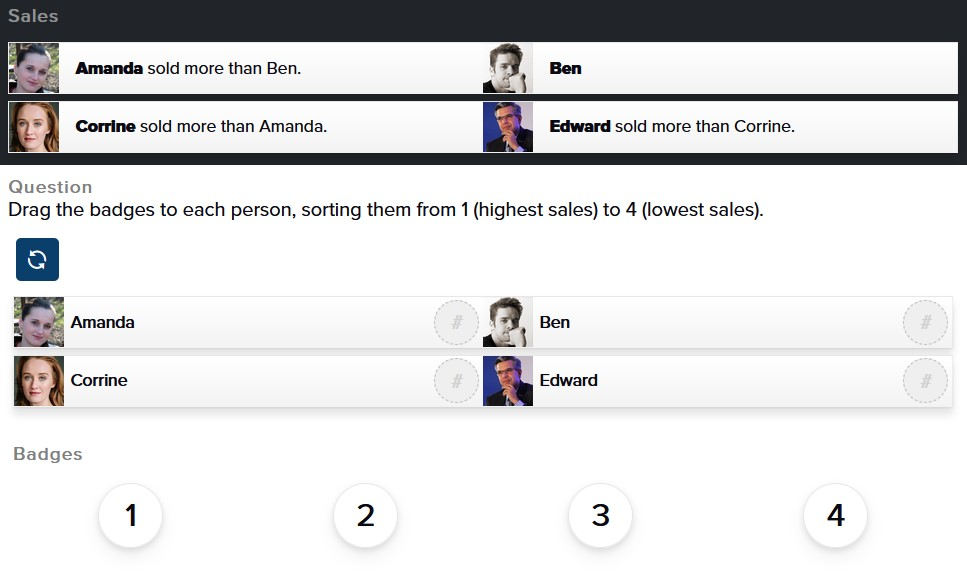
How to Answer:
- 1.Drag ranking numbers to the placeholder circles
- 2.Place numbers next to each individual
- 3.Use the blue reset button to start over if needed
3. Schedule Clash Style Questions
This question type involves analyzing multiple individual schedules to find suitable meeting times using a deductive method with constraints including:
- •Individual schedules
- •Time constraints
- •Available time blocks
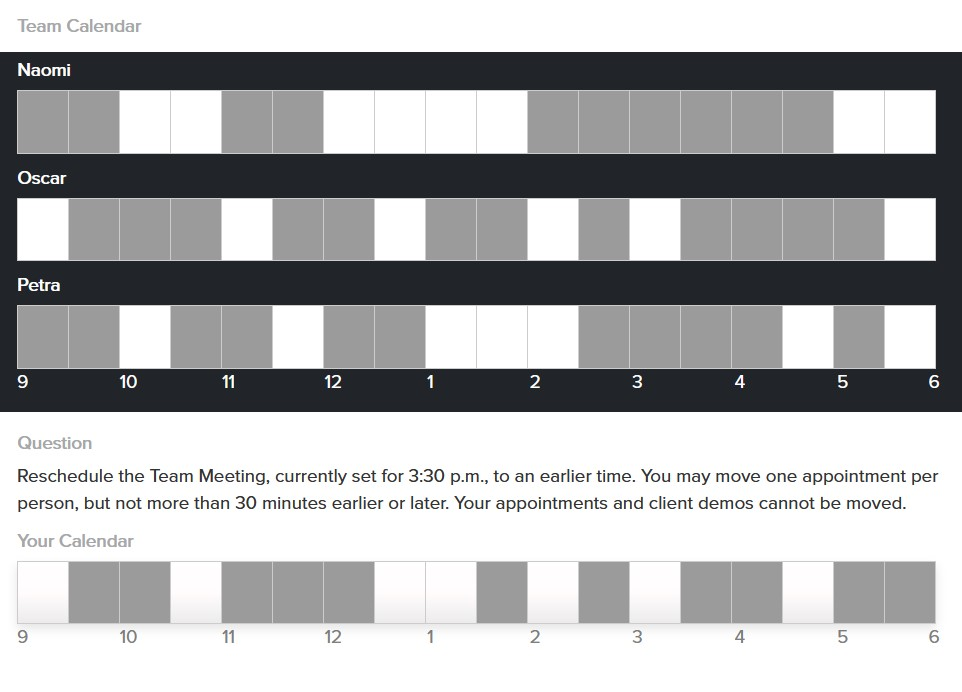
How to Answer:
- 1.Review all schedule requirements
- 2.Click on empty white blocks to select time slots
- 3.Selected blocks will change color to indicate your choice
4. Schedule Task Style Questions
This deductive example question type focuses on fitting tasks into available schedule slots based on specific requirements including:
- •Task ordering
- •Task duration
- •Available time slots
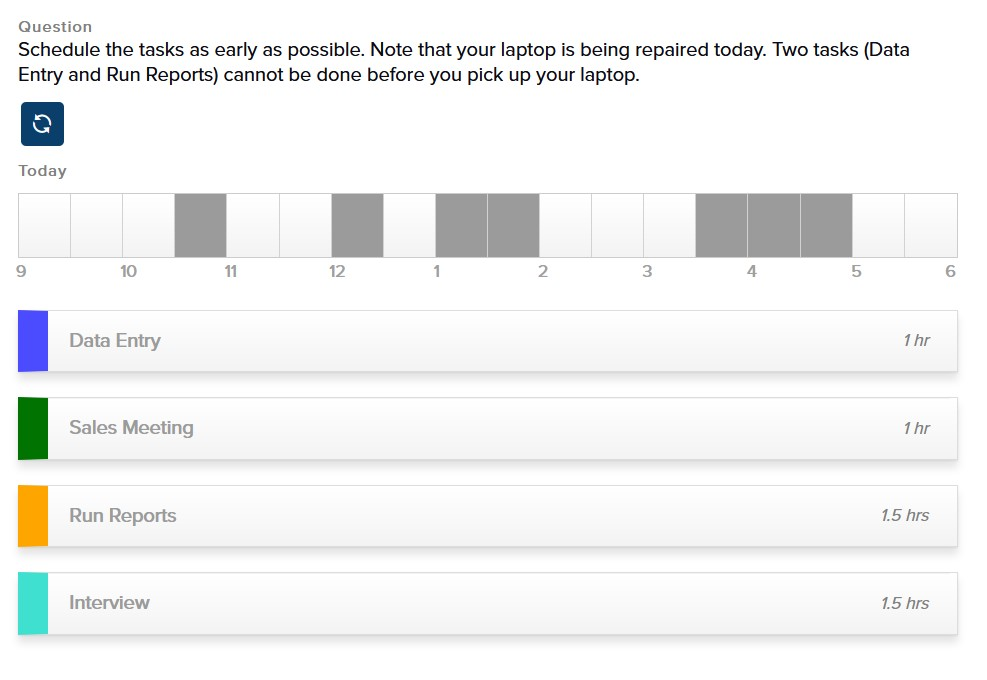
How to Answer:
- 1.Drag task rows to appropriate free slots
- 2.Slots will change color to match the task
- 3.Continue until all required tasks are assigned
5. Calendar Style Questions
This question type requires using deduction logic to identify appropriate days that meet various conditions presented in the question such as:
- •Individual availabilities
- •Holiday periods
- •Day preferences
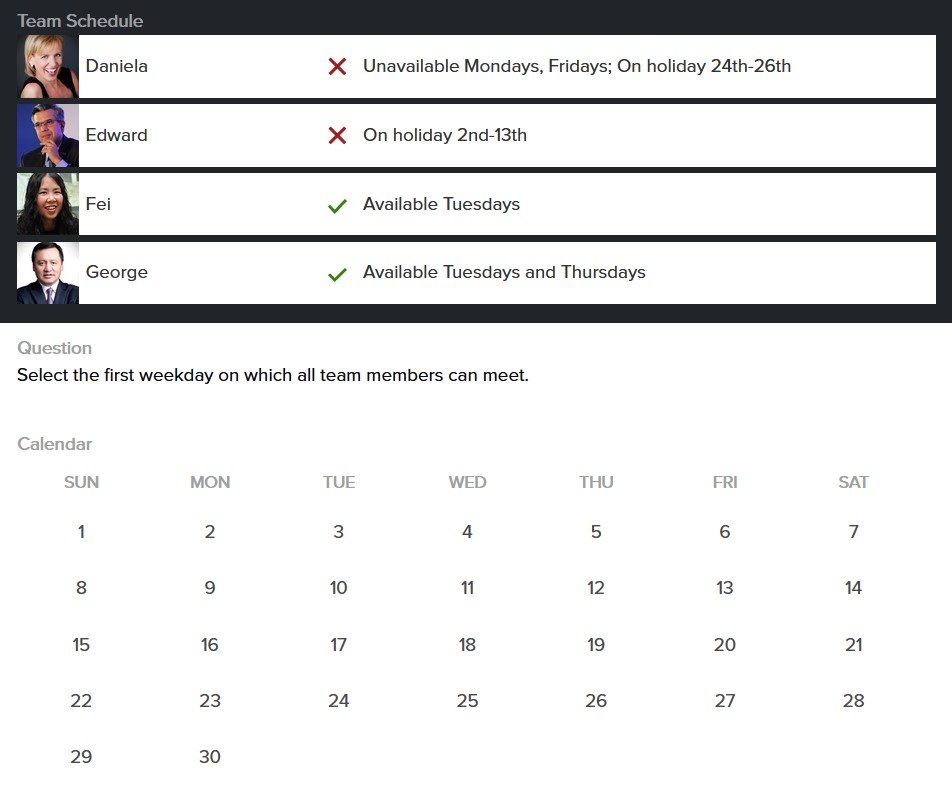
How to Answer:
- 1.Review all conditions carefully
- 2.Click on the appropriate calendar day
- 3.Verify all conditions are met
⚠️Note: Later questions may require selecting multiple days that meet the conditions.
Common Mistakes to Avoid in Deductive Reasoning Tests
- ❌
Making Assumptions
Stick to the given information only. Don't use external knowledge or make assumptions beyond what's stated.
- ❌
Ignoring Keywords
Pay careful attention to words like "all," "some," "only if," and "must" as they significantly change meaning.
- ❌
Overthinking Questions
Use the simplest logical approach first. The correct answer is usually straightforward.
- ❌
Poor Time Management
Don't spend too much time on one question. Take your best guess if your allocated time per question runs out, then come back if time permits. Pacing your time per question is super important - it's easy to spend too long on a problem and struggle to complete the test as a result. You must complete the entire test to avoid a score reduction.
FAQs About Deductive Reasoning Tests
How long is the SHL Deductive Reasoning Test?
The test lasts 36 minutes with 24-30 questions depending on the test variant you are given. This means you should spend approximately 70-90 seconds per question.
How is the SHL Verify G+ Deductive Reasoning Test scored?
The marking system uses a combination of work rate (number of questions answered), hit rate (number answered correctly), and question level (altered dynamically for each question based on your performance on the previous questions so far) which is combined with a comparison group at a particular ability level to produce a population percentile for your performance.
Can I prepare for a Deductive Reasoning Test?
Yes! Regular practice with SHL-style questions improves both accuracy and speed. Focus on understanding different question types and developing effective problem-solving strategies.
What is a good score for a Deductive Reasoning Test?
A score in the 75th percentile or above is considered strong. However, required scores vary by employer and position level.
Can I fail a Deductive Reasoning Test?
There's no strict pass or fail, but a low score may prevent you from proceeding in the recruitment process. Each employer sets their own minimum score requirements.
Ready to Practice?
Start preparing for your Deductive Reasoning Test with our free practice tests.
Try Our Free Practice Tests Now